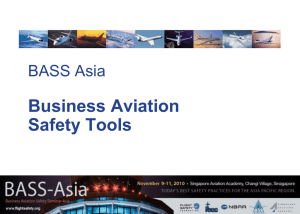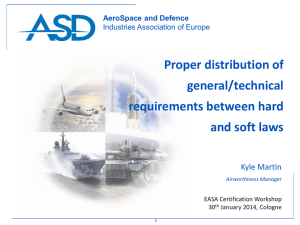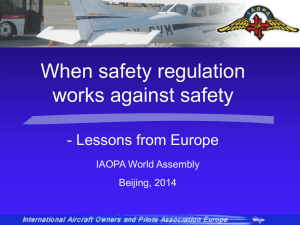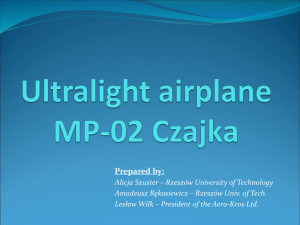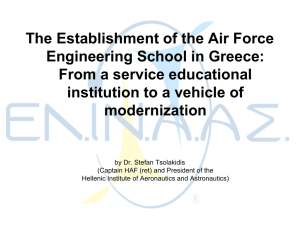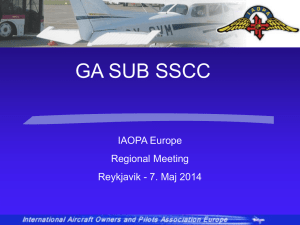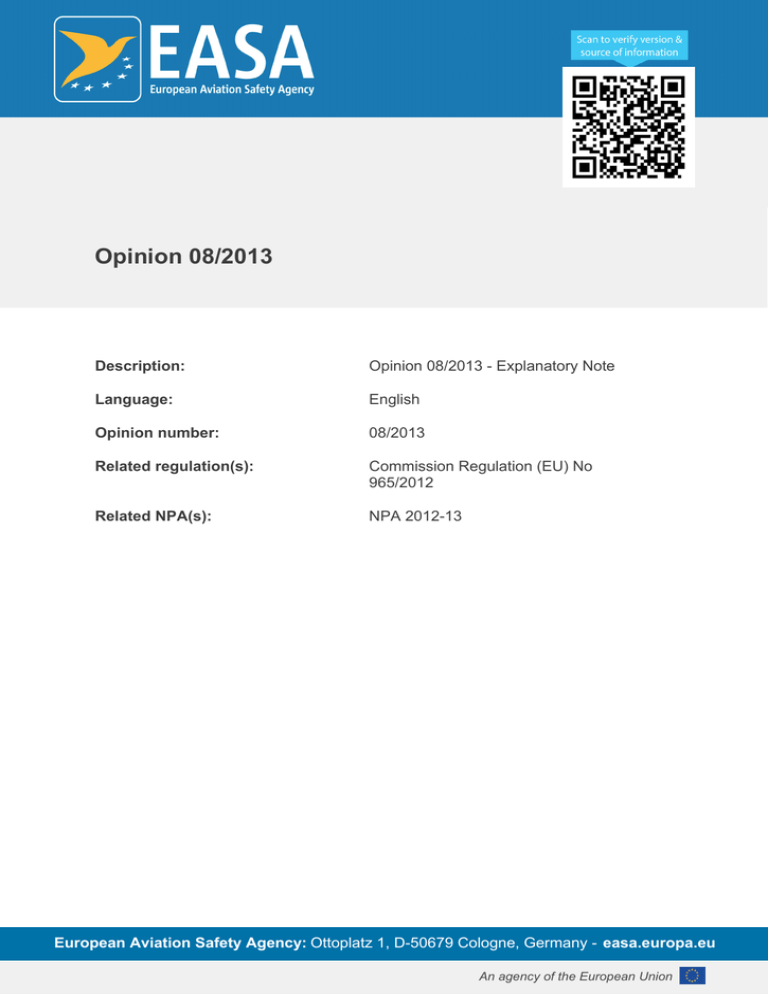
Opinion 08/2013
Description:
Opinion 08/2013 - Explanatory Note
Language:
English
Opinion number:
08/2013
Related regulation(s):
Commission Regulation (EU) No
965/2012
Related NPA(s):
NPA 2012-13
European Aviation Safety Agency: Ottoplatz 1, D-50679 Cologne, Germany - easa.europa.eu
An agency of the European Union
European Aviation Safety Agency — Rulemaking Directorate
Opinion No 08/2013
Additional Airworthiness Requirements for Operations
RELATED NPA/CRD 2012-13 — RMT.0110 (21.039(K)) — 18/09/2013
EXECUTIVE SUMMARY
In the Joint Aviation Authorities system, JAR-26 was introduced to make certain important newly
introduced airworthiness requirements applicable to aircraft in service. Up till now, these requirements
were enforced through national law, which will become obsolete through the full implementation of the
new EU Operations rules by 28 October 2014. Therefore, JAR-26 needs to be transposed into the EU
regulatory framework.
This Opinion proposes a new Commission Regulation with an Annex called ‘Part-26’, containing the highlevel safety objective, applicability, and compliance period for each of the proposed measures. This
Regulation will be complemented by an Agency Decision containing the Certification Specifications
providing the standard means to comply with the high-level requirements of Part-26.
The proposals in this Opinion are based on JAR-26 Amendment 3, adapted, when necessary, for
consistency with other current applicable requirements, and to address some identified implementation
issues.
The proposed regulation is expected to maintain the safety level as established through JAR-26.
Applicability
Affected
regulations
and decisions:
Part-26, Part-ORO
Affected
stakeholders:
Operators of large aeroplanes
Driver/origin:
safety
Reference:
Process map
Concept Paper:
Rulemaking group:
Terms of Reference:
RIA type:
Technical consultation
during NPA drafting:
Publication date of the NPA:
Duration of NPA consultation:
Review group:
Focussed consultation:
Publication date of the Decision:
TE.RPRO.00036-002 © European Aviation Safety Agency. All rights reserved.
Proprietary document. Copies are not controlled. Confirm revision status through the EASA Internet/Intranet.
No
No
09/08/2010
Light
No
2012/Q3
3 months
No
No
2014/Q4
Page 1 of 8
European Aviation Safety Agency
Opinion No 08/2013
Table of contents
Table of contents
1. Procedural information ............................................................................................. 3
1.1. The rule development procedure ............................................................................. 3
1.2. The structure of this Opinion and related documents ................................................. 3
1.3. The next steps in the procedure .............................................................................. 3
2. Explanatory Note ..................................................................................................... 5
2.1. Issues to be addressed .......................................................................................... 5
2.2. Objectives ............................................................................................................ 5
2.3. Outcome of the consultation ................................................................................... 5
2.4. Summary of the Regulatory Impact Assessment ....................................................... 6
2.5. Overview of the proposed Regulation ....................................................................... 7
3. References .............................................................................................................. 8
3.1. Affected regulations ............................................................................................... 8
3.2. Affected decisions ................................................................................................. 8
TE.RPRO.00036-002 © European Aviation Safety Agency. All rights reserved.
Proprietary document. Copies are not controlled. Confirm revision status through the EASA Internet/Intranet.
Page 2 of 8
European Aviation Safety Agency
Opinion No 08/2013
1. Procedural information
1.
Procedural information
1.1. The rule development procedure
The European Aviation Safety Agency (hereinafter referred to as the ‘Agency’) developed
this Opinion in line with Regulation (EC) No 216/2008 1 (hereinafter referred to as the
‘Basic Regulation’) and the Rulemaking Procedure2.
This rulemaking activity is included in the Agency’s Rulemaking Programme for 2013 under
RMT.0110 (21.039(k)). The scope and timescale of the task were defined in the related
Terms of Reference (see process map on the title page).
The draft text of this Opinion has been developed by the Agency. All interested parties
were consulted through NPA 2012-133. 54 comments were received from interested
parties, including industry, national aviation authorities, professional organisations, and
private companies.
The Agency has addressed and responded to the comments received on the NPA. The
comments received and the Agency’s responses are presented in the Comment-Response
Document (CRD) 2012-134. 4 reactions on the CRD were received from interested parties,
including industry and national aviation authorities.
The final text of this Opinion (i.e. Explanatory Note and draft regulations) has been
developed by the Agency.
The process map on the title page summarises the major milestones of this rulemaking
activity.
1.2. The structure of this Opinion and related documents
Chapter 1 of this Opinion contains the procedural information related to this task. Chapter
2 ‘Explanatory Note’ explains the core technical content. The draft rule text proposed by
the Agency is published on the Agency’s website5 together with this Opinion.
1.3. The next steps in the procedure
This Opinion contains a proposed new Union regulation on Additional Airworthiness
Requirements for Operations with an Annex referred to as ‘Part-26’. The Opinion is
addressed to the European Commission, which uses it as a technical basis to prepare a
legislative proposal.
The related Certification Specifications CS-26, that provide the standard means to show
compliance of products with the requirements of Part-26, will be published as a Decision of
the Executive Director of the Agency only when Part-26 is published by the European
1
2
3
4
5
Regulation (EC) No 216/2008 of the European Parliament and the Council of 20 February 2008 on common rules in the
field of civil aviation and establishing a European Aviation Safety Agency, and repealing Council Directive 91/670/EEC,
Regulation (EC) No 1592/2002 and Directive 2004/36/EC (OJ L 79, 19.3.2008, p. 1), as last amended by Commission
Regulation (EU) No 6/2013 of 8 January 2013 (OJ L 4, 9.1.2013, p. 34).
The Agency is bound to follow a structured rulemaking process as required by Article 52(1) of the Basic Regulation.
Such process has been adopted by the Agency’s Management Board and is referred to as the ‘Rulemaking Procedure’.
See Management Board Decision concerning the procedure to be applied by the Agency for the issuing of opinions,
certification specifications and guidance material (Rulemaking Procedure), EASA MB Decision No 01-2012
of 13 March 2013.
In accordance with Article 52 of the Basic Regulation and Articles 5(3) and 6 of the Rulemaking Procedure.
https://www.easa.europa.eu/rulemaking/docs/crd/2012/CRD%202012-13.pdf
http://easa.europa.eu/agency-measures/opinions.php
TE.RPRO.00036-002 © European Aviation Safety Agency. All rights reserved.
Proprietary document. Copies are not controlled. Confirm revision status through the EASA Internet/Intranet.
Page 3 of 8
European Aviation Safety Agency
Opinion No 08/2013
1. Procedural information
Commission. The draft CS-26 can be found in CRD 2012-13 and will remain unchanged
unless changes to Part-26 are made during the adoption process by the Commission which
necessitate changing the CS as well.
TE.RPRO.00036-002 © European Aviation Safety Agency. All rights reserved.
Proprietary document. Copies are not controlled. Confirm revision status through the EASA Internet/Intranet.
Page 4 of 8
European Aviation Safety Agency
Opinion No 08/2013
2. Explanatory Note
2.
Explanatory Note
2.1. Issues to be addressed
The safety recommendations from accident and incident investigations, technological
developments, and research often lead to new or improved design standards for aircraft
and are included in the Agency’s Certification Specifications. These standards are only
applicable to new aircraft types and to certain significant changes of existing types.
However, some of these new developments, if incorporated in the existing fleet of inservice aircraft, can bring considerable safety improvement. In the Joint Aviation
Authorities system, JAR-26 was introduced to make these requirements applicable to
aircraft in service. Up till now, JAR-26 was enforced through national law, which will
become obsolete through the full implementation of the new EU Operations rules by 28
October 2014. Therefore, JAR-26 needs to be transposed into the EU regulatory
framework.
The rules for aircraft certification in Commission Regulation (EU) No 748/2012 do not
provide for a possibility to impose new design standards to aircraft types that are already
certified. Consequently, a new dedicated Regulation is necessary to transpose the existing
set of measures as introduced in JAR-26 into the EU regulatory framework.
2.2. Objectives
The overall objectives of the EASA system are defined in Article 2 of the Basic Regulation.
This proposal will contribute to the achievement of the overall objectives by addressing the
issues outlined in Chapter 2.1. The specific objective of this proposal is to transfer existing
JAR-26 requirements into the EU legal framework in order to maintain the level of safety
that was targeted by JAR-26. Because similar provisions to the JAR-26 requirements are
also included in the FAA operational rule FAR Part 121, the proposal will also achieve
harmonisation with the US rules.
2.3. Outcome of the consultation
Many of the comments on the NPA related to the compatibility of the proposed Part-26 and
CS-26 provisions with earlier versions of the relevant certification standards. The Agency
confirmed the compatibility of these standards and where necessary included references or
amended the text.
Several NPA comments questioned the adequacy of the transition period. The Agency
considered the transition period adequate because:
—
due to the length of the rulemaking process stakeholders already know well in
advance that a requirement is being prepared;
—
Part-26 is a transposition of existing JAR-26 which should have been applied by all
EU operators; and
—
most of the requirements originate from technological and regulatory developments
that date back to more than 10–15 years.
Nevertheless, reactions on the CRD questioned the above assumption that JAR-26 was
implemented in all JAA Member States and, therefore, suggested reconsidering the
transition period. In addition, the reactions also foresaw some problems with providing
proof of compliance to Part-26 or CS-26 by the affected operators. Based on these
reactions, the Agency has decided to propose a longer transition period of two years
TE.RPRO.00036-002 © European Aviation Safety Agency. All rights reserved.
Proprietary document. Copies are not controlled. Confirm revision status through the EASA Internet/Intranet.
Page 5 of 8
European Aviation Safety Agency
Opinion No 08/2013
2. Explanatory Note
instead of one year. This will allow more time for the operators to show compliance. It will
also allow the Agency to provide further guidance on the methods of showing compliance.
One reaction on the CRD requested adding a requirement for the type certificate holders to
make available to operators a compliance to Part-26 checklist. Although the Agency agrees
that such a checklist can be useful for the operators, it does not agree to add a
requirement imposing this. The Agency wishes to stay as closely as possible to the existing
JAR-26 without changing the responsibilities of the affected stakeholders. Nevertheless,
the Agency recommends type certificate holders to make a checklist for compliance with
Part-26 available.
Another reaction requested to identify in the cross reference table of GM1 26.1 for which
Part-26 requirements compliance could be demonstrated only per visual inspection. The
Agency has currently not identified any Part-26 requirement for which compliance can be
demonstrated only by visual inspection. However, when practice would show that these
cases do exist, the Agency can easily update the cross reference table to confirm this.
Finally, a reaction asked to introduce in the future Operational Suitability Data (OSD)
process (see Agency Opinion No 07/2011) systematic Part-26 compliance demonstration
by the type certificate applicants. The Agency considers that the scope of the OSD process
is currently limited to crew type training and Master Minimum Equipment List, and it does
not include compliance with other requirements. Nevertheless, as already indicated above,
the Agency recommends type certificate holders and applicants to include Part-/CS-26
compliance in the type certification process and make available to operators a compliance
checklist.
2.4. Summary of the Regulatory Impact Assessment
As was the case for JAR-26, the additional airworthiness specifications for operations in the
proposed Part-26 will be applicable to the operators conducting commercial air transport
(CAT) with large aeroplanes. Consequently, these operators will be responsible for showing
compliance with the Part-26 requirements. When the basic type design of the affected
aircraft does not comply, compliance can be achieved by introducing modifications
designed by the TC holder as a change to the TC, or by third parties under a Supplemental
Type Certificate (STC).
The level of safety as achieved through the implementation of JAR-26 should be
maintained. In the few cases where JAR-26 was not implemented, the level of safety can
be increased.
In 2009, the Agency performed a survey regarding the level of compliance with JAR-26
amongst CAT operators in the EU. Through responses from 11 of the then 27 national
aviation authorities, the Agency estimated that 3.6% of the current fleet would not be fully
in compliance with the JAR/Part-26 provisions. The level of non-compliance could not be
established. Nevertheless, the Agency considers that the costs for the operators to bring
the fleet fully in compliance with Part-26 are not significant, and in any case
commensurate with the safety level obtained through these requirements.
As described above under 2.3., the Agency has decided to propose a longer transition
period of two years instead of one year. This will allow more time for the operators to show
compliance. It will also allow the Agency to provide further guidance on the methods of
showing compliance.
TE.RPRO.00036-002 © European Aviation Safety Agency. All rights reserved.
Proprietary document. Copies are not controlled. Confirm revision status through the EASA Internet/Intranet.
Page 6 of 8
European Aviation Safety Agency
Opinion No 08/2013
2. Explanatory Note
2.5. Overview of the proposed Regulation
The Agency’s Opinion proposes a new Commission Regulation implementing point 5(e)(vi)
of Regulation (EC) No 216/2008 with an Annex referred to as ‘Part-26’. This Part-26
transposes the high level safety requirements of JAR-26 into the EU regulatory framework.
Each JAR-26 paragraph is transferred into Part-26 paragraphs bearing the same number,
for consistency and ease of the transition from the old to the new system of rules.
When transposing JAR-26 into the EU regulatory framework, the Agency decided to split
each provision in elements to be included in Part-26 and other elements to go into CS-26.
This was done for the following reasons. In the EU system, only EU regulations can impose
generally binding rules on (natural or legal) persons so in order to make the former JAR-26
content binding, it has to be included in an EU regulation. At the same time also, it is
acknowledged that airworthiness standards need to be implemented in a flexible manner.
For new designs, the necessary flexibility is included in Part-21 which allows deviations
from the standards through special conditions or equivalent level of safety findings. The
same approach is not possible for the retroactive airworthiness requirements because
there is no possibility to establish a certification basis upon an application for an approval.
Therefore, the flexibility has to be found in limiting the binding law to high-level objectives,
applicability, and implementation dates only, and leaving the details in ‘soft law’ such as
CSs and GM. This approach has the advantage to allow enough flexibility for the addressee
of the requirement to establish the best way to comply with a certain safety requirement.
This also allows for a shorter process when an update of the technical requirements is
needed, as necessary to follow-up the pace of evolution of other CS. Finally, the existence
of a dedicated CS-26 allows for its inclusion, at the request of an applicant, in the
certification basis of new or changed products, which will allow a clear statement of
compliance with these provisions that can be used by the operators of these types or
changed types when demonstrating compliance with Part-26.
The initial version of Part-26 includes only the existing JAR-26 provisions and applies to
operators of large aeroplanes operated in commercial air transport, consistent with the
applicability of JAR-26. Further provisions will follow under separate rulemaking tasks,
which depending on the technical content, may also be applicable to other categories of
aircraft and/or operations and also to design approval holders or production organisations.
Each time a new airworthiness requirement needs to be imposed, an amendment to Part26 and CS-26 will be proposed through an NPA.
The new Part-26 will be applicable directly to the operators, and Member States can,
therefore, use existing national law to enforce it. However, the Agency considers that there
is a need to have a wider range of enforcement tools available to the Member States.
Therefore, this Opinion also proposes to include a cross reference to the new rule into the
rules for operators for obtaining an Air Operator Certificate.
Done at Cologne, on 18 September 2013.
P. KY
Executive Director
TE.RPRO.00036-002 © European Aviation Safety Agency. All rights reserved.
Proprietary document. Copies are not controlled. Confirm revision status through the EASA Internet/Intranet.
Page 7 of 8
European Aviation Safety Agency
Opinion No 08/2013
3. References
3.
References
3.1. Affected regulations
—
Commission Regulation (EU) No …/…. on additional airworthiness requirements for
operations;
—
Commission Regulation (EU) No 965/2012 of 5 October 2012 laying down technical
requirements and administrative procedures related to air operations pursuant to
Regulation (EC) No 216/2008 of the European Parliament and of the Council.(OJ L
296, 25.10.2012, p. 1)
3.2. Affected decisions
CS-26 Additional Airworthiness Specifications for Operations.
TE.RPRO.00036-002 © European Aviation Safety Agency. All rights reserved.
Proprietary document. Copies are not controlled. Confirm revision status through the EASA Internet/Intranet.
Page 8 of 8



